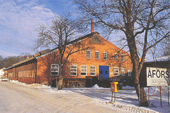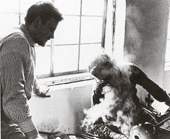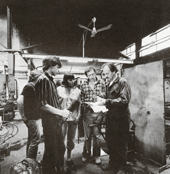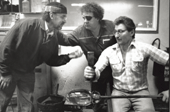|
Bertil
and Ulrica, came, as perfect strangers, to the small hamlet of Åfors
in 1963. The only lifeblood (of the little community) was provided
by a glass-factory, whose Director had been overtaken by the times.
There was no longer a demand for the production of fine crystal.
Åfors looked to Bertil to save them.
A visitor
to the glass factory, around the hour of 7, say, is sure to catch
sight of Bertil Vallien, either in the studio or on his way to the
workshop ('hotshop'): He likes to make an early start, in readiness
for new challenges in his role of artist/designer.
We who work there have come to depend on him as a problem solver
('trouble shooter'). Our faith in his ability to reap new successes
and thereby to defend employment and the survival of the glass-factory,
remains unshaken.
One tends
to forget that Bertil is free to do as he likes. But that is not
the way he operates. During his forty years at the Åfors factory
he has always taken responsibility for its survival. This is why
both he and Ulrica command the love and respect of us all. For without
them the Åfors factory would have been forced to close. We
are many who have had the privilege of working with them, and the
opportunity of following, at close hand, the unfolding of their
artistic careers. They have put Åfors on the map and we are
proud of having two of the world's finest glass-artists with us.
The present
factory is a new, totally renovated workplace for some hundred people.
Apart from the Valliens, two other artists, Gunnel Sahlin and Olle
Brozen, also work at the factory. But the history of Åfors
contains both successes and crises.
The Åfors
glassworks came into being at a time when factories were springing
up in every forest clearing on the eastern side of the Småland
province. Glass-making was a profitable business at that time. Sweden
was late in making the transition from an agricultural society to
an industrial one. High-class luxury goods gave way to everyday
utility glassware. One man who saw the opportunities was C-A Fagerlund,
a glass master from the district of Kosta. He used his savings,
and went into partnership with his two brothers and a brother-in-law,
to found a glass-factory in 1876. Not long after that he bought
out his partners, and acquired the nickname Big-Claus.
Big Claus
was a bizarre figure who did very much as he pleased. His thrift,
(read miserliness) gave the factory a bad name. Nobody wanted to
work for the low wages he paid. While he himself lived like a prince
(outside of the parish, that is). Many a tale is told of his outlandish
behaviour. How he had once hired a train for his own private use,
and how, upon arrival at the local station, the station master had
rolled out the red carpet, supposing it to be a royal visit!
He grew
old and mellower, and in 1916, he sold the factory to Ernst Johansson
for 150,000 Swedish kronor. Johansson put his son, Erik, in charge
of the factory. Erik changed his surname to Afors, after an attempt
on the part of his namesake (another Erik Johansson) to cheat him
out of the affair.
This
was the start of a brilliant entrepreneurial career. Erik Åfors
took over his competitors, Kosta, Boda, Johansfors and the Emmaboda
plate-glass factory, and became known as the Glass King. With him,
an era of stability for Åfors began. Life returned to the
community; skilled craftsmen were brought in, and received good
wages. (Although) The factory production consisted of cut glass
and moulded glass, artists were considered to be an unnecessary
expense.
However, in the 1950's things changed. There was no longer any call
for cut glass. Åfors was unwilling to relinquish his ideals,
and began stockpiling unsaleable goods. His motto was 'old is new'
- sooner or later the old times would come back again. But they
didn't, and he was obliged to accept the fact. In 1958, Erik Rosen,
the former successful director of Boda, took over as managing director
of the company. He in turn, was replaced by Erik Höglund, a
man with modernist ideas.
The first artist to be engaged at Åfors was Ernest Gordon
(1954.) Gordon, however, did not get along with EÅ and left
the factory in 1961.
Erik
Rosen heard of the up-and-coming student of ceramics, Bertil Vallien,
and recommended him to C-H Åfors, son of Erik, who offered
him a job at the end of his training. Bertil made up his mind while
in America, '61-'63, that if he returned to Sweden it would be to
work for Rosén - who, where artists were concerned, was in
favour of a long-term employment policy.
Now and
then Director Åfors would give Bertil a project that in Bertil's
view was completely passé. But he went along with it to just
to humour him, only to declare that "it hadn't got a hope in
hell!" In the end, Åfors accepted the fact that times
had changed - and the new aesthetic. Profits soared.
Erik
Åfors retired in 1975, at which time he sold the entire KostaBoda
concern to the *Uppsala-Ekeby Porcelain Company, with the stipulation
that the factory should not be closed down during his lifetime.
He died in 1983.
In March
1987, it was announced that Åfors was to close, and that production
would be taken over by other factories within the concern. There
were wild protests and eventually the then owner, Robert Weil (who
is also a personal friend of Bertil and Ulrica) intervened. In 1995,
the glass-factory underwent a comprehensive renovation.
Åfors
is now part of the Orrefors KostaBoda conglommerate. There are two
distinct brand names, Orrefors and KostaBoda. A major part of the
concern is now Danish-owned.
|

Åfors
glassfactory.

Bertil
and masterblower Ingvar Johnsson in the Åfors hotshop in the
middle of the 60´s.

In
the hotshop in the middle of the 70´s. Bertil among the family
Johansson. From right to left:Roland, Birgitta och Tomas. Photo:
Ola Terje.

Sandcasting
in the hotshop with Cemal Yousseinof and Bertil Vallient. Photo:
Ola Terje.

Bertil
with glassartist Dale Chihuly and Master - blower Anton Koch.

Erik
Rosén, legendary CO between 1947 to 1978.

Former
swedish king Gustav VI Adolf (1950-1973) at the left with the "Glass
king" Erik Åfors.The photo was taken in the 50´s.
|


